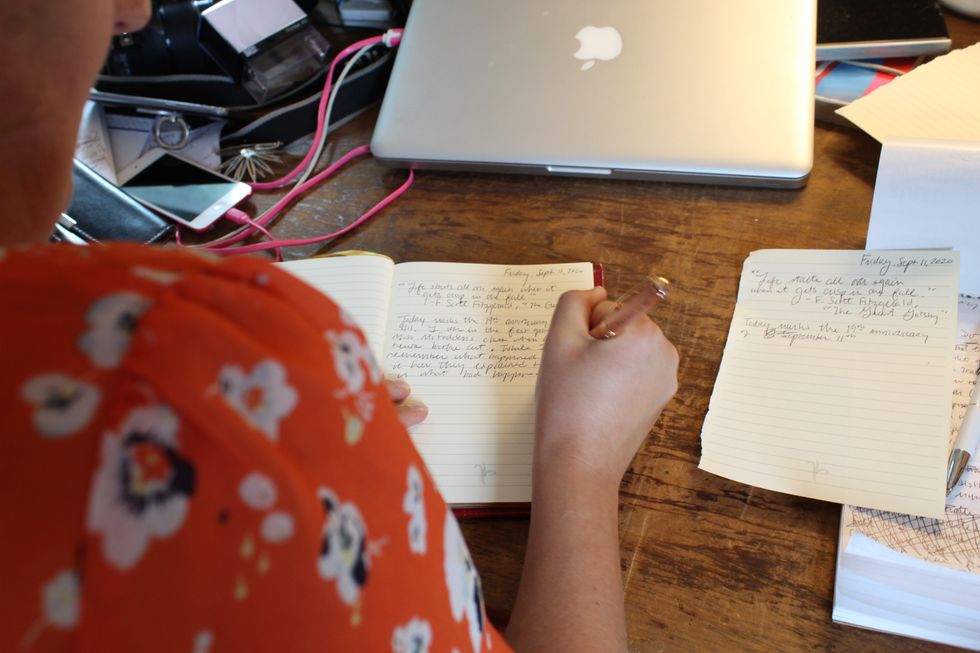Turning The Page This Fall With Journaling

Millerton News reporter Kaitlin Lyle advocates for journaling as a way to store memories and also to work out problems you aren’t necessarily ready to talk about yet. Photo by Hunter O. Lyle

Take it from someone who’s been practicing the art of journaling for more than a decade: You may just discover more about yourself with a pen in hand and a blank page than you might suspect.
For some, journaling can be therapeutic: A few flicks of the wrist and you can feel confident that your thoughts are secure with a silent listener.
Others may use it to preserve memories, to jot down the woes and wonders of everyday life or to even find a way to approach conflicts they’re too anxious to talk about out loud.
I first turned to journaling in high school and continued writing through college; this year, I’ve been using journaling to chronicle stories from the COVID-19 pandemic. Thanks to the thoughtfulness of friends and family members, I haven’t needed to buy myself a new journal in years, though that hasn’t stopped me from admiring the ones I see on display at stores around here.
The journal you purchase can reflect the way you want to tell your story. Are you looking for something small that you can whip out of your pocket at a moment’s notice? If so, you might enjoy a Moleskine Classic Notebook, a Moleskine Volant Journal or a Moleskine Cahier Journal. If you want to see how they fit your own pockets or pocketbook, you can see and purchase them in person at Oblong Books & Music in Millerton, N.Y.,or you can check Barnes and Nobles in Kingston, N.Y., most Staples stores and most Target stores.
If you don’t want one of the Moleskines (which were, famously, the notebook of choice for Ernest Hemingway and Pable Picasso), art supply stores such as JWS on Railroad Street in Great Barrington, Mass., always have interesting options for journaling.
You can even buy heavy stock paper there and cut the sheets to be exactly the size you want, then custom cover them with the fabric or leather of your choice (you can also buy beautiful leather journals at Barnes and Noble; some are neat and tidy and others have unfinished edges that make them feel very “Lord of the Rings”).
Over in Kent, Conn., House of Books carries a line of leather journals from Rustico, with colors ranging from buckskin to black to burgundy.
Young writers looking for a space to confide their thoughts in the manner of iconic YA heroine Harriet the Spy can always turn to the classic black-and-white marbled composition notebook, available at most stores and pharmacies. (Drip some juice from a tomato sandwich onto one of the pages, for a true Harriet the Spy experience.)
Those seeking encouragement while trying a hand at journaling might want to pick up an inspirational journal. These journals are designed with an uplifting message on the front cover to empower the journaler and can be found at most art supply and stationery stores, and online at Anthropologie.
Journalers who like to keep track of the passing days can pick up a dated journal at Staples.
Ocean State Job Lot in Torrington, Conn., also has an unexpectedly large and diverse selection of art supplies, notebooks and dated journals.
Oblong Books & Music in Millerton sells a special Bibliophile Reader’s Journal, an ideal gift for book lovers and writers. Many vendors of books and journals also carry the decorative and entertaining Wreck This Journal line, which encourages the destruction of the journal with poked pen holes, spilled coffee, drips from tomato sandwiches (see the above reference to Harriet the Spy) and defaced photos. This might be a good place to start for anyone who is ambivalent about journaling; perhaps it will prove to be a gateway to more pacific and productive journaling. If not, perhaps it will offer a good aggression outlet.
The opposite of the Wreck This Journal books is the Bullet Journal craze (well, it was a craze last year). This innovative series reminds us that we don’t have to put everything in electronic form on our phones and computers — we can write it down. On paper. With a pen.
Devotees of Bullet Journals keep lists of their favorite pens. The biggest supplies of diverse pens can be found at Big Box stores such as Staples and Target; and small, independent stores that sell art supplies, such as Oblong, JWS and Tom’s Toys in Great Barrington. You can also find an excellent selection of pens at craft stores such as Michael’s and Joann (they have shops in Torrington, Conn., and Kingston).
The Salisbury Winter Sports Association (SWSA) will host its annual Junior Jump Camp, a two-day introduction to ski jumping, on Saturday and Sunday, Dec. 27 and 28, from 9 a.m. to 2 p.m. at Satre Hill in Salisbury.
The camp is open to children ages 7 and up and focuses on teaching the basics of ski jumping, with an emphasis on safety, balance and control, using SWSA’s smallest hill. No prior experience is required.
The cost is $50 per child and includes instruction and lunch on both days. For more information or to register, visit www.skireg.com/swsa-camp or email info@jumpfest.org
Jesse Bunce, first selectman of North Canaan.
LITCHFIELD — The Northwest Hills Council of Governments welcomed six newly elected municipal leaders Thursday, Dec. 11, at its first meeting following the 2025 municipal elections.
The council — a regional planning body representing 21 towns in northwest Connecticut — coordinates transportation, emergency planning, housing, economic development and other shared municipal services.
Barkhamsted First Selectman Meaghan Cook, Goshen First Selectman Seth Breakell, Kent First Selectman Eric Epstein, Norfolk First Selectman Henry Tirrell, North Canaan First Selectman Jesse Bunce and Torrington Mayor Molly Spino were each elected to their post in November.
They filled the seats of their predecessors on the COG, who were each given a toast of appreciation: Nick Lukiwsky (Barkhamsted), Todd Carusillo (Goshen), Marty Lindenmeyer (Kent), Matt Riiska (Norfolk), Brian Ohler (North Canaan) and Elinor Carbone (Torrington).
COG Executive Director Rob Phillips said the outgoing members were given a going away mug that read “You’re living the dream still.” Members voted to appoint Warren First Selectman Greg LaCava to fill a vacancy on the Council’s Executive Committee. COG members voted by paper ballot, and LaCava defeated Burlington First Selectman Doug Thompson for the vacant seat.
Ryan Segalla takes a fadeaway shot over a defender.
FALLS VILLAGE — Housatonic Valley Regional High School’s boys basketball team defeated Pine Plains High School 60-22 in a scrimmage Tuesday, Dec. 9. The non-league preseason game gave both sides an opportunity to run the court ahead of the 2025-26 varsity season.
HVRHS’s senior-heavy roster played with power and poise. The boys pulled ahead early and kept their foot on the gas through to the end.
By halftime the score was 33-8. Junior varsity players subbed in for the second half, but not before the starters got some in-game dunk practice. By the end Housatonic totaled 60 points to Pine Plains’ 22.

Nick Crodelle led the Mountaineers offensively with 13 points. Anthony Labbadia and Wyatt Bayer scored nine points each. Anthony Foley scored eight points. Owen Riemer and Ryan Segalla each scored seven points. Peyton Bushnell hit a three-pointer. Jaxon Visockis and Henry Berry each scored two points.
HVRHS begins Berkshire League competition on the road at Nonnewaug High School Tuesday, Dec. 16, with a 6 p.m. tip off.


Katie Moore delivers toys to the Stuff a Truck campaign held by the Kent Volunteer Fire Department last weekend. Donated toys are collected so that parents, who need some assistance, may provide their children with gifts this Christmas. Accepting the donation are elves Fran Goodsell and Karen Iannucci
KENT — Santa’s elves were toasty warm as they collected toys for the children of Kent.
Keeping with annual tradition, Fran Goodsell and Karen Iannucci manned the Stuff a Truck campaign sponsored by the Kent Volunteer Fire Department on Saturday, Dec. 6, and Sunday, Dec. 7. Sitting in front of a fire pit in the firehouse parking lot between donations from residents, they spoke of the incredible generosity displayed every season. That spirit of giving was clear from the piles of toys heaped on a table.
“This is always so gratifying,” said Goodsell, noting that certain businesses, including High Watch Recovery Center, Wilson’s, and Kent and South Kent schools needed a “shout out” for all they’ve done. She said South Kent School focuses on gifts for older children, which is a group that often is overlooked.
Unwrapped contributions are sought for children 1 to 15 years old who might otherwise find little or nothing from Santa, they said. The bounty will be set up at the Community House on Thursday, allowing parents to come and take what they want. If there are still items left, grandparents are invited to “shop.”
The atmosphere was festive Saturday, as a stuffed dog began barking a Christmas tune whenever someone walked in front of it. A large decked-out bear posted at the parking lot entrance reminded passersby of the event. Visiting children were able to get a close-up look at the fire truck and walk through the firehouse if they wished.
Goodsell and Iannucci were very grateful to those who donated wood for the fire pit. “And so many asked if they could bring us coffee or hot chocolate,” said Iannucci.
Goodsell said many who came talked about having grown children who were recipients of the gifts when their families were struggling. “They are so glad to be able to give back,” she said.